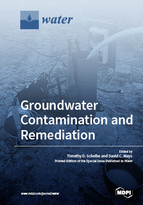Groundwater Contamination and Remediation
A special issue of Water (ISSN 2073-4441). This special issue belongs to the section "Water Quality and Contamination".
Deadline for manuscript submissions: closed (20 June 2018) | Viewed by 46093
Special Issue Editors
Interests: groundwater; reactive transport; biogeochemistry; microbial transport; heterogeneity; multiscale modelling; pore scale modelling; river-groundwater interactions; computational earth science
Special Issue Information
Dear Colleagues,
Groundwater is a critical natural resource that can be degraded by contamination. Contaminants can have natural sources (e.g., arsenic or salinity) or anthropogenic sources (e.g., industrial chemicals, pesticides, or sewage effluent). Remediation activities aim to reduce or eliminate groundwater contaminants, and can include passive methods (e.g., monitored natural attenuation), ex-situ methods (e.g., pump-and-treat), or in-situ methods (e.g., bioremediation or chemical oxidation).
The aim of this Special Issue of Water is to present new research contributions in the broad area of groundwater contamination and remediation. This topic includes studies that elucidate critical processes controlling contaminant sources, transport, and fate in the subsurface environment, methods to identify the concentration and extent of contaminant plumes, as well as novel approaches to predict and enhance the performance of remediation techniques. We encourage contributions on both natural and anthropogenic contaminants, as well as emerging contaminants, such as manufactured nanoparticles or hydraulic fracturing fluids. The breadth of cutting-edge research addressing these topics is substantial, so accordingly this Special Issue will not be able to include studies specifically focused on evaluating the human health impacts of contaminants (i.e., epidemiological studies).
Dr. Timothy D. Scheibe
Prof. Dr. David C. Mays
Guest Editors
Manuscript Submission Information
Manuscripts should be submitted online at www.mdpi.com by registering and logging in to this website. Once you are registered, click here to go to the submission form. Manuscripts can be submitted until the deadline. All submissions that pass pre-check are peer-reviewed. Accepted papers will be published continuously in the journal (as soon as accepted) and will be listed together on the special issue website. Research articles, review articles as well as short communications are invited. For planned papers, a title and short abstract (about 100 words) can be sent to the Editorial Office for announcement on this website.
Submitted manuscripts should not have been published previously, nor be under consideration for publication elsewhere (except conference proceedings papers). All manuscripts are thoroughly refereed through a single-blind peer-review process. A guide for authors and other relevant information for submission of manuscripts is available on the Instructions for Authors page. Water is an international peer-reviewed open access semimonthly journal published by MDPI.
Please visit the Instructions for Authors page before submitting a manuscript. The Article Processing Charge (APC) for publication in this open access journal is 2600 CHF (Swiss Francs). Submitted papers should be well formatted and use good English. Authors may use MDPI's English editing service prior to publication or during author revisions.
Keywords
- Groundwater
- contamination
- remediation
- reactive transport
- monitored natural attenuation
- bioremediation
- water quality







